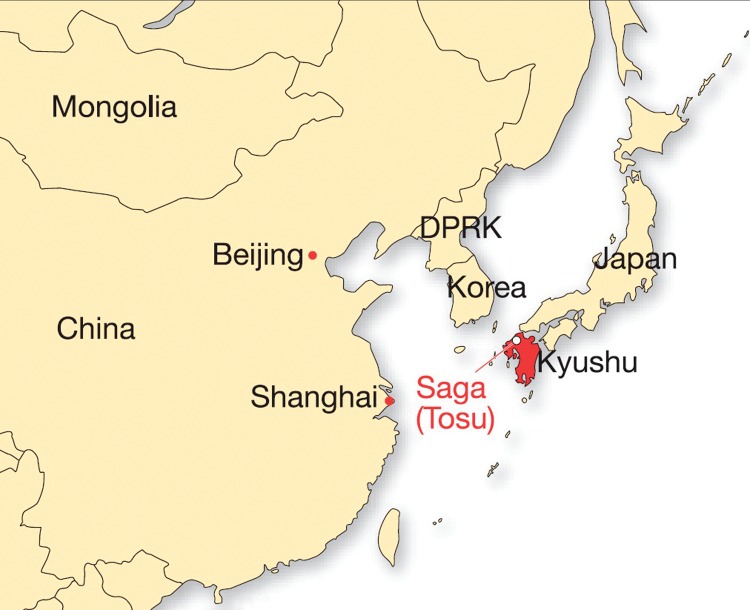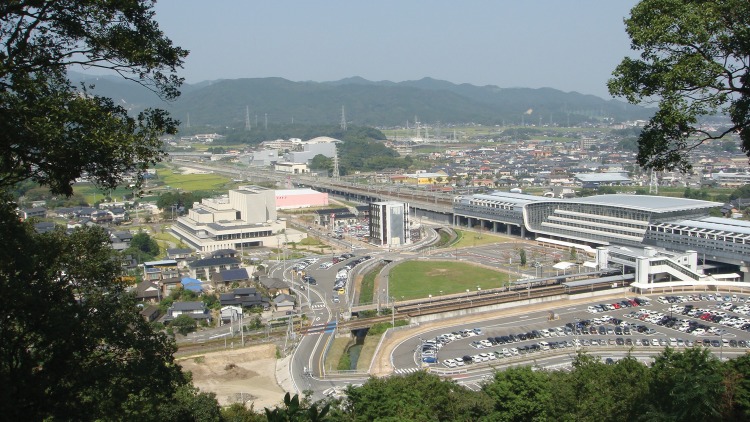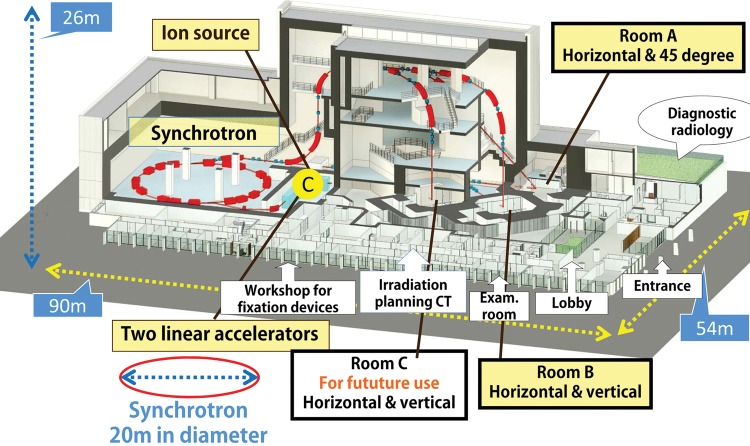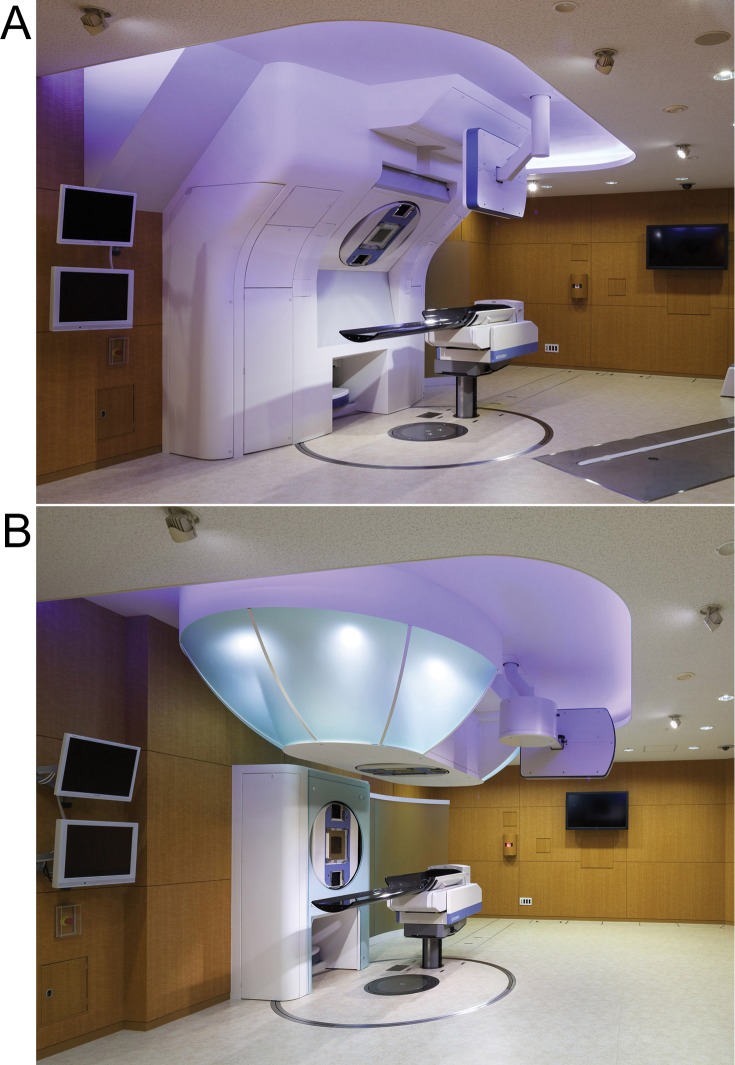SAGA HIMAT [1], the fourth carbon ion beam therapy facility in Japan, is located in Tosu city, Saga prefecture (Figures 1 and 2). The SAGA HIMAT Project is a collaborative work among the local governments, regional industries, and medical societies in the Kyushu area. The initial cost of this facility was approximately ¥15 billion, which was covered by donations, investments, and local government aid. The facility is managed by a nonprofit organization, SAGA HIMAT Foundation.
Figure 1.
SAGA HIMAT is located in Tosu city, Saga prefecture, Japan.
Figure 2.
SAGA HIMAT (left) is very close to Shin-Tosu station (right), which is at the cross-point of Kyushu- Shinkansen and Nagasaki-Honsen railways.
At SAGA HIMAT [2], carbon ions are accelerated to up to 70% of light speed by 2 linear accelerators and a synchrotron. The accelerated ion beams are transported to treatment rooms A and B. The range of extracted energy is 140 to 400 MeV/u (Table 1). Room A has horizontal and 45° oblique beam lines; room B has horizontal and vertical beam lines. Broad beams are used and each outlet measures 15 cm × 15 cm (Figures 3 and 4). In preparation for treatment, radiation technologists create an immobilization device customized for each patient placed on a mock treatment couch. Dose compensation boluses adjusted to the shape of the irradiation fields are designed from the computed tomography (CT) simulation data and produced by outside manufacturers. We also have a regular CT scanner and magnetic resonance imaging for diagnosis. Treatment room C is now under construction for pencil beam scanning therapy.
Table.
Specifications at SAGA HIMAT.
| Ion species |
12C |
| Ion source | Electron cyclotron resonance ion source |
| Injector linacs | Radio-frequency quadrupole linac; 0.6MeV/u |
| Alternating phase focusing interdigital H-mode drift tube linac; 4MeV/u | |
| Synchrotron | Circumference 61.5 m |
| Extracted energy | 140-400 MeV/u |
| Beam intensity | 1.0 × 109pps |
| Irradiation size | 15 × 15cm2 (broad beams in room A and B) |
| Treatment rooms | A (horizontal and 45° oblique beams) |
| B (horizontal and vertical beams) | |
| C (horizontal and vertical beams for future scanning therapy) |
Figure 3.
Facility layout of SAGA HIMAT.
Figure 4.
(A) Treatment room A has horizontal and 45° oblique beam lines. (B) Treatment room B has horizontal and vertical beam lines.
SAGA HIMAT is a stand-alone outpatient clinic specialized for carbon ion cancer therapy. The patients initially visit a cancer treatment facility of their choice, receive a diagnosis and staging of the cancer, and are referred to our institution for carbon ion therapy. We do not have beds. All patients are treated as outpatients. If necessary, a small number of patients may be admitted to nearby affiliated hospitals and commute to SAGA HIMAT for their therapy. After completion of their therapy, patients are observed regularly at our clinic and at the original institute.
Our medical staff includes 5 radiation oncologists, 1 diagnostic radiologist, 4 medical physicists, 10 radiology technologists, and 7 nurses. The 6 accelerator operators are outsourced. Most of the initial medical staff were trained at the National Institute of Radiological Sciences in Chiba or at Gunma University for 3 months to 3 years. The radiology departments of 3 nearby university hospitals (Saga, Kurume, and Kyushu) are particularly committed to this project. They train and provide the medical staff for SAGA HIMAT. They also have ion beam therapy consultation clinics and select patients for carbon ion therapy. In order to smoothly perform patient referral and treatment, we have exchanged medical agreements with many institutes, including 10 university hospitals and many major cancer institutions in the Kyushu area. The population of Kyushu is about 13 million.
Our treatment protocols are mainly based on results from the National Institute of Radiological Sciences. Furthermore, clinical review boards for 9 different organs (genitourinary, head and neck, lung and mediastinum, liver, pancreas, bone and soft tissue, recurrent rectal, esophageal, and gynecological tumors) were formed to check and discuss our treatment protocols and clinical results. The board members consist of cancer authorities, including surgeons, medical oncologists, radiation oncologists, pathologists, and statistics professionals from outside facilities. They also help with patient referral and advise us on designing the clinical studies.
Construction of the building and the accelerators took 1 year and 8 months. The acceptance tests took 8 months, and the commissioning tests for prostate cancers took 2 months. We opened the clinic in June 2013 and started treatment of prostatic cancers in August 2013, while continuing commissioning tests for other organ cancers. Treatment of head and neck cancers and bone and soft tissue tumors started in December 2013. Respiratory gated treatment for lung, liver, and pancreas cancers started in March 2014. By August 2015, we had treated 910 patients, including 610 prostatic, 80 liver, 71 lung, 50 head and neck, 51 pancreatic, 17 bone and soft tissue, 10 local recurrent rectal, 3 renal, and 17 other cancers.
We are now preparing for treatment protocols for esophageal and gynecological cancers. Treatment room C will be ready for pencil beam scanning beam therapy in 2017. We plan to treat more than 800 patients a year in the near future. We are also making preparations to accept some patients from foreign countries. We hope carbon ion therapy will become a major option to treat cancer patients and that SAGA HIMAT will become a model of multifacility collaboration for cancer treatment.
ADDITIONAL INFORMATION AND DECLARATIONS
Conflicts of interest: The authors have no conflicts to disclose.
References
- 1.SAGA HIMAT. 2014 http://www.saga-himat.jp/ Accessed September 16, 2015.
- 2.Kudo S. Clinical experience of SAGA HIMAT. Paper presented at the HIMAC International Symposium 2015, 20th Year Anniversary Event. January 19-20, 2015. Tokyo, Japan.






